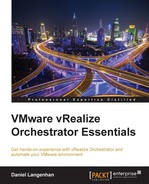As we saw in the last section, exporting a workflow will only export it and not the objects that we used in it. Therefore, we should have a look at packages. Packages export and import all the dependent objects that are needed to run the workflow and not just a single object.
Before we go ahead and export a package, we have to create one, as follows:
- In your Orchestrator Client, make sure that you are in the Design mode.
-
Click on Packages,
 .
.
-
Select Add Package,
 , from the side menu.
, from the side menu.
- As package name, select
com.packtpub.Orchestrator-essentials. - You will see that a new package has been added to the end of the package list.

Now that we have created the package, we need to fill it with objects, as follows:
- Starting from where we left off, right-click on the newly created package and select Edit.
- Select Workflows.
- Click on the green + button.
- Find the InstallFreshVM workflow, mark it, and click on Select.
- You will now see that the workflow has been added along with all the other workflows that we used in it.

- When you click on Actions, you will find out that a lot of actions have also been added, along with the translateOS2GuestOS that we created in Chapter 6, Advanced vRO Scripting with JavaScript. These are all the actions that are used by the other workflows that have been added.
- Click on Save and close to exit the workflow package and save its contents.
We have now created an Orchestrator package that contains all the spoils of our work.
Let's export this package so that we can share it with others:
- Go to the Package tab and select the
com.packtpub.Orchestrator-essentialspackage. - Right-click on the package and select Rebuild package. This option will refresh the package and make sure that all the essential components are in the package. Note that this will add all the common plug-in library actions and workflows to your workflow again.
- Right-click on the workflow and select Export package.
- Click on Save.
A file named com.packtpub.Orchestrator-essentials.package will be saved to your local disk.

As you can see, there are quite a lot of options for exporting. The following table summarizes what each option does:
Last but not least, we will import a package into Orchestrator. This is something that we really cannot showcase that much without a second Orchestrator, but we will still show it so that you know how to do it:
- Go to the Package tab in another Orchestrator.
-
Click on the Import package,
 .
.
- Select the file of the package that you would like to import and click on Open.
- The Import package wizard will show the package certificate that we created in Chapter 2, Deploying and Configuring the Orchestrator Appliance, and ask whether you would like to import this certificate only once or import and trust it. Select one:

- You will now see a bigger window that shows all the workflows and actions that this package contains. Orchestrator checks the version numbers of the workflows and actions against the one that you are trying to import. A green arrow means that Orchestrator will import the workflow. A red one means that it won't, because the versions are the same or the signatures don't match. Grey arrows indicate that the versions match and hence, the import won't take place. You can override this selection by checking off the checkbox, but you should be careful with this. Click on Import selected elements:

The package is now added to Orchestrator, and you will find it in the Package section. You will also find out that the workflow folders that you created as well as the action modules are also imported. Have a look around.
